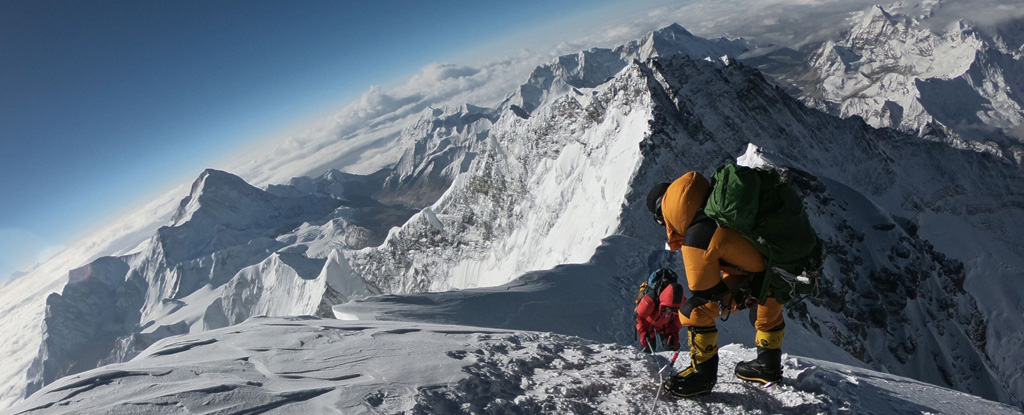The human body functions best at sea level. Down here, the oxygen level is sufficient for our brains and lungs. At much higher altitudes, our bodies cannot function properly.
But if mountaineers want to scale Mount Everest, the world’s highest peak at 29,029 feet (8,848 meters or 5.5 miles) above sea level, they must brave the so-called “death zone.”
This is the area at over 8,000 meters where there is so little oxygen that the body begins to die minute by minute, cell by cell.
In the death zone, climbers’ brains and lungs starve for oxygen, their risk of heart attack and stroke increases, and their judgment quickly becomes impaired.
“Your body is breaking down and essentially dying,” Shaunna Burke, a mountaineer who scaled Everest in 2005, told Business Insider. “It’s going to be a race against the clock.”
2019, At least 11 people died on Everest, who spent almost all of their time in the death zone. It has become one of the deadliest seasons on Everest in recent memory.
Some expedition companies blamed the crowds for these deaths, noting that the peak got too high so choked with climbers during a rare period of fine weather that people were stuck in the dead zone for too long.
On May 22, 2019, 250 climbers attempted to reach the summit, This was reported by the Kathmandu Postand many climbers had to queue to go up and down.
These additional unplanned hours in the death zone may have brought the 11 people those at higher risk died, although it is difficult to pinpoint the specific causes of each death.
One climber said climbing Everest feels like walking on a treadmill and breathing through a straw.
At sea level, the air contains about 21 percent oxygen. But at altitudes over 12,000 feet, The oxygen content is 40 percent lower.
Jeremy Windsor, a doctor who climbed Everest in 2007 as part of it the Caudwell Xtreme Everest Expedition, said Everest blogger Mark Horrell that blood samples from four climbers in the death zone showed that the climbers got by on only a quarter of the oxygen they needed at sea level.
“These numbers were comparable to numbers found in patients on the verge of death,” Windsor said.
Five miles above sea level, the air is so low in oxygen that even with extra air tanks, it can feel like “walking on a treadmill and breathing through a straw.” according to climber and filmmaker David Breashears.
Climbers have to get used to the lack of oxygen
A lack of oxygen leads to myriad health risks. When the amount of oxygen in your blood falls below a certain level, your heart rate increases to up to 140 beats per minute, increasing your risk of a heart attack.
Climbers must give their bodies time to adjust to the lung-damaging conditions in the Himalayas before attempting to scale Everest.
Expeditions generally make at least three trips up the mountain from Everest Base Camp (which, at 17,600 feet, is higher than almost any mountain in Europe), going a few thousand feet higher on each consecutive trip before reaching the summit.
During these weeks at high altitude, The body begins to produce more hemoglobin (the protein in red blood cells that helps carry oxygen from the lungs to the rest of the body) to compensate.
But too much hemoglobin can thicken your blood and make it harder for the heart to pump blood around the body. This can lead to a stroke or fluid buildup in the lungs.
A condition called high-altitude pulmonary edema (HAPE) is common on Everest — a quick stethoscope check can reveal a clicking sound when fluid that has entered the lungs is rattling around.
Other symptoms include Fatigue, a feeling of suffocation at night, weakness, and a persistent cough that produces white, watery, or frothy fluid. Sometimes the cough is so severe that ribs can break or separate.
Climbers with HAPE are always short of breath, even at rest.
In the death zone, your brain can swell, causing nausea and a form of psychosis
Acclimating to death zone altitudes just isn’t possible, according to altitude expert and physician Peter Hackett said PBS.
One of the biggest risk factors at 26,000 feet is hypoxia, a lack of adequate oxygen circulation to organs like your brain. When the brain doesn’t get enough oxygen, it can swell, leading to a condition called high-altitude cerebral edema (HACE). Essentially, it’s HAPE for the brain.
This swelling can cause nausea, vomiting, and difficulty thinking and reasoning.
A deprived brain can cause climbers to forget where they are and fall into what some experts consider a type of delirium altitude psychosis.
Hypoxic climbers have impaired judgment and have been known to do strange things, such as starting to undress or talk to imaginary friends.
Other potential dangers include insomnia, snow blindness, and vomiting
Burke said she suffered from a constant, unrelenting cough while climbing.
“Every second or third breath, your body gasps and you wake up,” she said.
The air was so thin that she couldn’t sleep properly.
“People will start to deteriorate,” Hackett added. “Sleeping becomes a problem. Muscle wasting occurs. Weight loss occurs.”
Nausea and vomiting from altitude-related illnesses, including HAPE and HACE, also cause a decrease in appetite. The glare of endless snow and ice can cause snow blindness — temporary loss of vision or ruptured blood vessels in your eyes.
Temperatures in the death zone never rise above zero degrees Fahrenheit. “Any exposed skin freezes instantly,” Burke said.
Loss of blood flow to climbers’ fingers and toes can lead to frostbite and in severe cases – when the skin and underlying tissues die – to gangrene. gangrenous tissue often has to be amputated.
All of this physical debilitation and visual impairment can lead to accidental falls. According to Burke, fatigue is everywhere.
“It takes everything to put one foot in front of the other,” she said.
Poor decision-making can also result in climbers forgetting to re-attach a safety line, deviating from the route, or not properly preparing life-saving equipment such as oxygen tanks.
Climbers can climb through the death zone in a day, but they can wait in line for hours
Climbing in the death zone is “a hell on earth,” as noted by Everest climber and 1998 NOVA Expedition member David Carter said PBS.
Typically, climbers attempting to conquer the summit attempt to ascend and descend in a single day and spend as little time as possible in the death zone before returning to safer altitudes. But that frenzied rush to the finish line comes at the end of weeks of scrambling.
Lhakpa Sherpa who has reached the summit of Everest nine times (more than any other woman on earth) to Business Insider that the day a group attempts to climb Everest is by far the most difficult time of the trek.
In order to climb the summit successfully, everything has to be right. Around 10 p.m. the climbers leave Camp Four at 8,000 meters. The first part of their ascent is completed in the dark, illuminated by starlight and headlamps.
Climbers usually reach the summit about seven hours later. After a short break for celebrations and photos, the expeditions head back, make the 12-hour trek back to safety, and (ideally) arrive before dark.
This article was originally published by Business Insider.
More from Business Insider:





